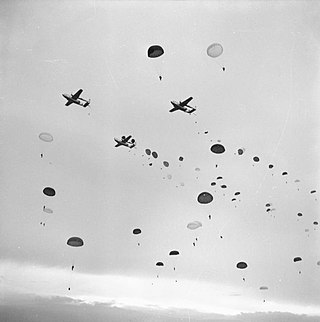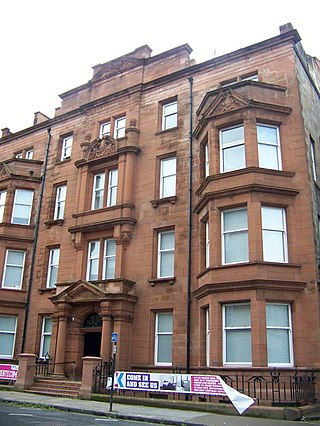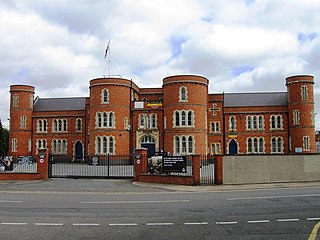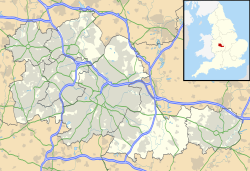
The Royal Warwickshire Regiment, previously titled the 6th Regiment of Foot, was a line infantry regiment of the British Army in continuous existence for 283 years. The regiment saw service in many conflicts and wars, including the Second Boer War and both the First and Second World Wars. On 1 May 1963, the regiment was re-titled, for the final time, as the Royal Warwickshire Fusiliers and became part of the Fusilier Brigade.

The 143rd Infantry Brigade was an infantry brigade of the British Army that saw active service in both the First and the Second World Wars. In the First World War the brigade served on both Western Front and later the Italian Front. During the Second World War the brigade fought in Belgium and France before being evacuated to England where it remained for the rest of the war and was finally disbanded in 1946. Raised again in the 1980s, this brigade disbanded under Army 2020 in November 2014.
The 1957 White Paper on Defence was a British white paper issued in March 1957 setting forth the perceived future of the British military. It had profound effects on all aspects of the defence industry but probably the most affected was the British aircraft industry. Duncan Sandys, the recently appointed Minister of Defence, produced the paper. The decisions were influenced by two major factors: the finances of the country and the coming of the missile age.
In September 1939, the British Army was in process of expanding their anti-aircraft and mobile assets. Among these new changes was the formation of Anti-Aircraft Command which was formed on 1 April 1939, and the 1st Armoured Division formed in 1937. The list below will include the British Army units, colonial units, and those units which were in the process of formation.

The 16th Airborne Division was an airborne infantry division of the British Territorial Army. It was first commanded by Major-General Roy Urquhart, and had its divisional headquarters in London.

The 2nd Anti-Aircraft Division was an Air Defence formation of the British Army from 1935 to 1942. It controlled anti-aircraft gun and searchlight units of the Territorial Army (TA) defending the East Midlands and East Anglia during The Blitz.
The 32nd (Midland) Anti-Aircraft Brigade was an air defence formation of Anti-Aircraft Command in Britain's Territorial Army (TA) from 1936 to 1955, charged with defending the East Midlands of England.
The Birmingham Rifles was a volunteer unit of the British Army founded in Birmingham in 1859. As the 5th Battalion, Royal Warwickshire Regiment, it served as infantry on the Western Front and in Italy during World War I. Its successor units served in air defence during the early part of World War II, and later as anti-tank gunners in the Burma Campaign.

The 59th (Warwickshire) Searchlight Regiment, Royal Artillery was an air defence unit of the Territorial Army (TA), part of the British Army, and was raised in Birmingham in 1938 just before the Second World War. It later served as a light anti-aircraft gun unit and continued in the postwar TA.
The 54th Anti-Aircraft Brigade was an air defence formation of Britain's Territorial Army (TA) formed immediately before the outbreak of the Second World War. It was engaged in defending the West Midlands of England during the war. It comprised a varying number of searchlight (S/L) battalions and later included light anti-aircraft units. It was disbanded at the end of 1943. When the TA was reconstituted in 1947, the former 54th AA Bde was reformed as 80 Anti-Aircraft Brigade but was disbanded on 9 September 1948.
The 1st Northamptonshire Rifle Volunteers were a unit of the British Army raised from 1859 onwards as a group of originally separate Rifle Volunteer Corps (RVCs). They later became the 4th Volunteer Battalion of the Northamptonshire Regiment and saw action in the Gallipoli and Palestine campaigns during the First World War. Converted into a searchlight unit between the wars, they served in the defence of the United Kingdom and as an infantry regiment in liberated Norway during the Second World War. Postwar they continued in the air defence role until 1961 when they reverted to infantry as part of the Royal Anglian Regiment.
The Huntingdonshire Cyclist Battalion was a bicycle infantry battalion of the British Army. Formed in the Territorial Force in February 1914, it remained in the United Kingdom throughout the First World War. After the war, in 1920, it was converted to infantry and became the 5th (Huntingdonshire) Battalion, Northamptonshire Regiment, in the Territorial Army. The battalion saw extensive service in the Second World War, fighting in France in 1940, Tunisia from 1942–43 and later Sicily and Italy from 1943–45 before ending the war in May 1945 in Austria. It continued to serve after the Second World War until May 1961 when it was amalgamated with the 4th Battalion, Northamptonshire Regiment, to form the 4th/5th Battalion, Northamptonshire Regiment.

The West Princes Street drill hall is a former military installation in Glasgow, Scotland.

The Baker Street drill hall is a former military installation in Abergavenny in Wales.

The Clare Street drill hall is a military installation in Northampton, Northamptonshire. It is a Grade II listed building.

The 6th Battalion, Hampshire Regiment was an infantry battalion of the British Army. Part of the Volunteer Force, later the Territorial Force, the battalion was part of the Hampshire Regiment and recruited from Portsmouth, Hampshire. It served as infantry during World War I and as a Royal Artillery regiment during and after World War II.

The Church Street drill hall is a former military installation in Brighton. It is a Grade II listed building.

The 6th Battalion, Royal Warwickshire Regiment was a unit of Britain's Territorial Army (TA) from 1908 until 1961. Recruited from Birmingham, it served as infantry in some of the bloodiest fighting on the Western Front and in Italy during World War I. Converted to an Anti-Aircraft (AA) role, it defended the West Midlands during The Blitz in the early part of World War II, and then joined Eighth Army in North Africa, including service in the famous Siege of Tobruk and in the Italian Campaign. It served on in the air defence role in the postwar TA until 1961.

The 2nd Northumberland Rifle Volunteer Corps, also referred to as the Tynemouth Rifles, was an infantry unit of Britain's part-time force, the Territorial Army. The corps was raised during the expansion of the Volunteer movement in the 1850s and then served with the Territorial Force during the First World War. It converted to an anti-aircraft role just prior to Second World War, and continued to serve until it was amalgamated in 1950.












